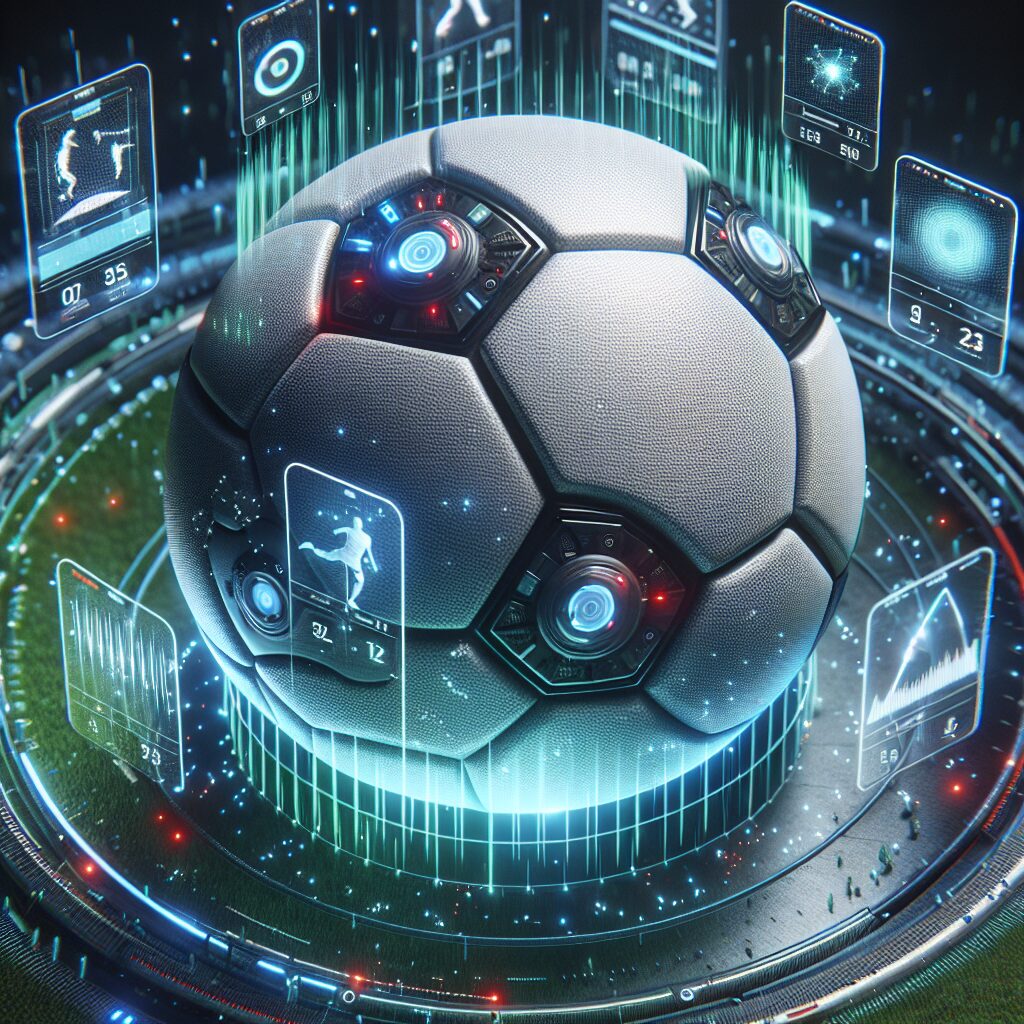In the world of sports, performance analysis plays a crucial role in improving athletes’ skills and strategies. Recently, a groundbreaking innovation has emerged in this field: sensor-equipped balls. These high-tech balls are embedded with sensors that capture and analyze various data points, providing athletes and coaches with valuable insights into their performance. The integration of sensors in sports equipment offers a revolutionary way to enhance training, optimize performance, and take sports analysis to a whole new level.
One of the unique features of sensor-equipped balls is their ability to track and analyze key performance metrics in real-time. These sensors can measure variables such as ball speed, trajectory, spin, and impact force, offering detailed and accurate data about the athlete’s technique and performance. The data collected by these balls can be instantly transmitted to a connected device, such as a smartphone or tablet, enabling athletes and coaches to access and interpret the information immediately. This real-time feedback empowers athletes to make adjustments and improvements on the fly, leading to more effective training sessions and better overall performance.
In the next part of this article, we will explore the key takeaways of using sensor-equipped balls in performance analysis. We will discuss how these high-tech balls can revolutionize sports training and provide athletes with a competitive edge. Additionally, we will delve into the potential impacts of this technology on sports analytics, coaching methodologies, and the overall evolution of the sports industry. So, let’s dive in and discover the future of performance analysis with sensor-equipped balls.
Key Takeaways
1. Sensor-equipped balls are emerging as a groundbreaking tool for performance analysis in various sports, providing accurate and real-time data on crucial parameters like trajectory, speed, spin, and impact forces.
2. The integration of sensor technology into balls enables athletes and coaches to delve deeper into their performance and make data-driven decisions to improve technique, strategy, and overall game understanding.
3. These smart balls offer significant advantages over conventional methods of performance analysis, such as video analysis or wearable sensors, by providing more objective and precise measurements directly from the point of contact between the ball and player or equipment.
4. This advanced technology is being embraced across different sports, including soccer, basketball, golf, tennis, and even baseball, enhancing training sessions, player development, injury prevention, and overall game tactics and strategies.
5. However, challenges exist in terms of standardization, cost, and integration with existing infrastructures, which need to be addressed for wider adoption of sensor-equipped balls in professional and amateur sports.
What Makes Sensor-Equipped Balls the Future of Performance Analysis?
The Importance of Performance Analysis in Sports
In the world of sports, understanding and analyzing performance is crucial for athletes, coaches, and trainers. Performance analysis provides valuable insights into an athlete’s strengths, weaknesses, and areas for improvement. It aids in optimizing training techniques, enhancing skills, and strategizing game plans. Traditionally, performance analysis has relied on manual data collection methods, but with the advent of sensor-equipped balls, a new era of analysis has emerged.
The Evolution of Sensor-Equipped Balls
Sensor-equipped balls have revolutionized performance analysis by capturing an array of data during training sessions or matches. These advanced balls are embedded with sensors that capture essential information such as speed, spin, trajectory, force, and impact. The data collected by these sensors is then transmitted wirelessly to a receiver or a mobile device for further analysis. This cutting-edge technology has transformed the way performance is monitored and evaluated.
Enhancing Training and Skill Development
Sensor-equipped balls offer unparalleled benefits in terms of training and skill development. By providing accurate and real-time data, athletes can track their performance metrics more effectively. This information empowers athletes to identify areas that require improvement or adjustment, helping them enhance their training regimen. Coaches and trainers can also utilize this data to tailor training programs to individual needs, focusing on specific aspects of performance that require attention.
Gaining Tactical Insights
Analyzing the data captured by sensor-equipped balls allows coaches and trainers to gain tactical insights into the game. By understanding how the ball behaves under different circumstances, such as varying playing surfaces or weather conditions, teams can devise more effective strategies. They can analyze patterns and trends in ball movement, player positioning, and passing accuracy, enabling them to develop game plans that maximize their chances of success.
Injury Prevention and Player Safety
Sensor-equipped balls are not just beneficial for performance analysis but can also contribute to injury prevention and player safety. By continuously monitoring forces and impacts during training or matches, these balls can help identify potentially harmful situations. Excessive forces or impacts detected by the sensors can alert trainers and medical staff to intervene and take necessary precautions. This proactive approach can lessen the risk of injuries and ensure the well-being of athletes.
Futuristic Possibilities and Innovations
The future of sensor-equipped balls holds limitless possibilities. With ongoing advancements in technology, these balls can further evolve to capture additional data points and offer more comprehensive performance analysis. Integration with augmented reality (AR) or virtual reality (VR) technologies could enhance training experiences, allowing athletes to visualize and simulate precise game scenarios. Moreover, the potential integration of artificial intelligence (AI) could provide real-time insights and automated performance feedback.
Guides for Utilizing Sensor-Equipped Balls Effectively
- How to properly calibrate sensor-equipped balls for accurate data collection?
- Understanding the different data parameters captured by sensor-equipped balls.
- Utilizing performance analytics software to interpret and analyze the data.
- Developing tailored training programs based on performance analysis.
- Utilizing tactical insights for game strategy and player positioning.
- Implementing injury prevention protocols based on sensor data.
- Staying up-to-date with the latest advancements in sensor-equipped ball technology.
- Exploring the potential integration of AR, VR, and AI in performance analysis.
FAQ
1. How do sensor-equipped balls work?
Sensor-equipped balls contain built-in sensors that can track various metrics such as speed, spin, trajectory, and impact force. These sensors collect data during the game or practice session, which can then be analyzed to provide insights into an athlete’s performance.
2. Are sensor-equipped balls only used in specific sports?
No, sensor-equipped balls have applications in various sports such as soccer, basketball, golf, tennis, and more. The technology can be tailored to meet the needs of different sports, providing valuable performance analysis in each respective field.
3. How accurate are the measurements provided by sensor-equipped balls?
The accuracy of the measurements depends on the quality of the sensors used in the balls. However, with advancements in technology, sensor-equipped balls have become increasingly accurate, providing reliable and precise data for performance analysis.
4. Can sensor-equipped balls be used for training purposes?
Absolutely! Sensor-equipped balls are an excellent tool for training. The data collected can be analyzed to identify areas for improvement, track progress, and optimize training sessions. Athletes and coaches can make data-driven decisions to enhance overall performance.
5. Do sensor-equipped balls require any special equipment or software?
In most cases, sensor-equipped balls come with their own dedicated mobile applications or software that allows users to sync and analyze the collected data. Some balls may require additional equipment, such as a smartphone or a compatible device, to access and interpret the data.
6. Are sensor-equipped balls expensive?
The cost of sensor-equipped balls can vary depending on the brand, quality, and features. While some higher-end options might be relatively more expensive, there are also affordable alternatives available in the market. It’s crucial to consider the value and benefits the technology brings to performance analysis when assessing the cost.
7. Are there any privacy concerns with sensor-equipped balls?
Privacy is a valid concern when it comes to collecting and analyzing personal data. Manufacturers of sensor-equipped balls should prioritize data privacy and implement strong security measures. Users should also review the privacy policy and terms of use of any accompanying applications or software before utilizing the technology.
8. Can sensor-equipped balls be used in professional sports?
Yes, sensor-equipped balls can be used in professional sports. Many sports organizations and teams embrace technology to gain a competitive edge. The data provided by sensor-equipped balls can offer valuable insights that help athletes and coaches make informed decisions and improve performance.
9. Are sensor-equipped balls useful for amateur players?
Absolutely! Sensor-equipped balls are not limited to professional athletes. Amateur players can benefit greatly from using this technology as well. It allows them to monitor their performance, identify areas for improvement, and track progress, thereby enhancing their overall skills and gameplay.
10. Can sensor-equipped balls help prevent injuries?
While sensor-equipped balls primarily focus on performance analysis, certain measurements and data can indirectly contribute to injury prevention. By understanding factors such as impact force, joint mechanics, and technique, athletes and coaches can optimize training methods and minimize the risk of injuries.
Final Thoughts
As the technology surrounding sensor-equipped balls continues to evolve, the future of performance analysis in sports looks incredibly promising. The availability of accurate and real-time data opens up new possibilities for athletes, coaches, and teams to gain a competitive edge.
By harnessing the power of sensor-equipped balls, performance analysis becomes more data-driven, objective, and effective than ever before. With insights derived from the collected data, athletes can tailor their training, correct weaknesses, and maximize their potential. This technology revolutionizes the way performance is understood, making it an exciting frontier for sports enthusiasts and professionals alike.




